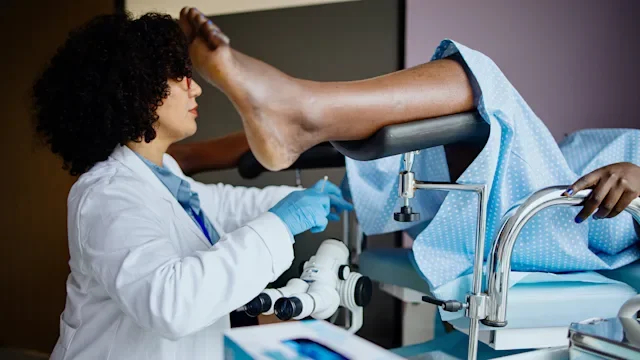The normal vagina
A healthy vagina is made up of “healthy” and “unhealthy” microbes that live in harmony.
What does a healthy vagina look like?
A healthy vagina may look different for everyone! Vaginas differ in:
Length
Shape
Color
Texture
To know what a healthy vagina looks like, take some time to get to know yours.
Get to know your own vagina
You can get comfortable with your vagina by doing a self-exam with a handheld mirror. Start with the outer and inner lips of the vagina, the fleshy folds of skin that surround the vaginal opening. These are called the labia or the vulva, and can vary in color, ranging from pink to dark brown to black. Check for any:
Lumps
Bumps
Sores
Rashes
The more often you do a self-exam, the better you will know what is normal for you.
1 in 4 women do not know where their vagina is.
The clitoris is a spongy tissue sitting at the top of the vulva (toward the front of your body), where the inner labia meet. It swells when you are aroused.
Within the inner labia, there are two holes:
To the front, right below the clitoris, is a small opening called the urethra. This is where you pee from.
Behind the urethra is the larger vaginal opening. In most people, the vagina is the connection between the uterus and outside. This is where menstrual blood exits your body, where sexual intercourse can happen, and where babies are born from.
Read more like this
Explore these related articles, suggested for readers like you.
The anal opening is further to the back, between your buttocks. It is the last part of the rectum, where stool leaves the body.

What does a healthy vagina smell like?
All healthy vaginas have a smell. Each vagina’s odor is unique, and varies depending on what phase of the menstrual cycle you’re in. It can also be affected by your personal hygiene practices. Vaginal odor can smell different when there is an underlying vaginal infection, called vaginitis. In most cases, vaginal odor will smell bad during an infection. The smell can sometimes be described as “fishy” or “rotten.” Knowing how your vagina typically smells will help you recognize when things are not right.
Is there such a thing as “healthy” vaginal discharge?
Some vaginal discharge is normal. Healthy vaginal discharge is usually clear or white and odorless. Depending on the phase of the menstrual cycle, vaginal discharge can be thin or thick. For example, outside of your menstrual bleed, vaginal discharge is usually thick and white. Right around the time of ovulation, vaginal discharge tends to be clear, mucousy, and “stretchy.” After your period, vaginal discharge turns brown as your vagina cleans out leftover blood. You might notice other differences in your discharge related to your birth control method and your sexual activity.
A change in the normal pattern of the color and smell of your discharge could be a sign of infection or inflammation in the vagina.
What is vaginal pH and why does it matter?
The vagina’s acidic environment protects it from infection. The pH is the number that measures how acidic or alkaline (the opposite of acidic) something is. The lower the pH number (7 and under), the more acidic something is. Higher pH numbers (7 and above) mean something is alkaline.
A healthy vagina has a pH of 4.5 or lower. A special balance of healthy microbes in the vagina helps keep it acidic to guard against infection. Some of these healthy microbes, bacteria called Lactobacilli, keep the vagina acidic by producing lactic acid and hydrogen peroxide. If the pH of the vagina becomes less acidic, this is usually a sign that there are not enough healthy microbes in the vagina to protect it from irritants or infection.
Estrogen, one of the female sex hormones, encourages healthy Lactobacilli and an acidic pH in the vagina. As estrogen and progesterone levels change throughout the menstrual cycle, and throughout life, so do the levels of healthy bacteria and the pH of the vagina.
Douching, or washing the inside of the vagina, can also affect vaginal pH. There are some over-the-counter cleansers and moisturizers that can help maintain a normal vaginal pH if needed, but generally speaking, the inside of your vagina does not need active cleaning. Only the external genitals need washing — and water and plain soap are more than enough.
What are the signs and symptoms of an “unhealthy” vagina?
The delicate balance of healthy microbes becomes unbalanced from:
Improper hygiene
Exposure to an irritant or allergen
Increased stress
Illness
Unsafe sex
When this happens, several symptoms occur that may suggest that your vagina is unhealthy or that there is an underlying vaginal infection. These symptoms include:
Itching
Burning
Abnormal vaginal discharge
Pain
Odor
Lumps/bumps
Rashes
Caring for your vagina
Keeping your vagina healthy isn’t difficult. But if you don’t understand how the vagina works, you might be disturbing its natural wellbeing without even knowing it.
Here are some recommendations for good vaginal health
Don’t scratch it when it itches.
Don’t douche.
Wear white, 100% cotton underwear and loose clothing. Avoid nylon and rayon.
Avoid pantyliners and thongs.
Use unscented tampons for menstrual bleeding. Don’t leave tampons in for longer than 8 hours.
Use mild, unscented soap for showering and bathing.
Avoid detergents, dryer sheets, and fabric softeners with fragrance.
Avoid feminine sprays/deodorants, bubble baths, bath oils, talc, and powder.
How to clean your vagina
Cleaning your genitals should be part of your daily routine. But cleaning the inside of your vagina is not needed. Using a little amount of soap and warm water, clean the outer and inner parts of the vulva. Use your fingertips instead of a washcloth, to avoid irritating the skin. Pat your vulva dry with a soft towel once you’re clean.
The vagina is self-cleaning.
You should also wipe from front to back after using the toilet. And as always, practice safe sex by using condoms to avoid contracting or spreading infections.
Vaginal products
You do not have to use vaginal products to clean the vagina. Less is more when it comes to keeping good vaginal hygiene. For menopausal women who are concerned about genital symptoms including vaginal dryness, burning, and irritation, there are over-the-counter products that freshen up and moisturize the vagina. They come in creams, gels, and vaginal suppositories. Vaginal suppositories (also known as pessaries) are solid medications that are inserted in the vagina with a vaginal applicator.
Vaginal and vulvar moisturizers creams and gels
Replens
Gyne-Moistrin
Creme de la Femme
Aloe Cadabra
V Magic
Hyaluronic acid inserts
Revaree
Hyalogyn
Vitamin E suppositories
Carlson Key-E
Natural oils
Coconut oil or olive oil
Getting help
If you think you have a vaginal infection, you may choose to treat yourself with a home remedy. This can be safe in the following situations:
Your symptoms are mild, and you don’t have fevers or chills.
You are not pregnant.
You don’t have an underlying medical condition that weakens your immune system.
You’ve had similar symptoms in the past, and you know what to do.
You don’t think you could have a sexually transmitted infection.
You should see a healthcare provider in these circumstances:
Home remedies have failed.
You have severe or recurrent symptoms.
You have fever or pelvic (lower abdominal) pain.
You think you could have a sexually transmitted infection.
You’re not sure what the problem is.
If you don’t have health insurance or an active medical provider, there are several services that can provide a consultation and prescription online.
Common concerns
References
Borges, S., Silva, J., & Teixeira, P. (2014). The role of lactobacilli and probiotics in maintaining vaginal health. Archives of Gynecology and Obstetrics, 289(3), 479-489.
Brabant, G. (2016). Bacterial vaginosis and spontaneous preterm birth. Journal de Gynécologie Obstétrique et Biologie de la Reproduction, 45(10), 1247-1260.
Buchta, V. (2018). Vaginal microbiome. Ceska Gynekologie, 83(5), 371-379.
Cardone, A., Zarcone, R., Borrelli, A., et al. (2003). Utilisation of hydrogen peroxide in the treatment of recurrent bacterial vaginosis. Minerva Ginecologica, 55(6), 483-492.
Centers for Disease Control and Prevention. (2020). Bacterial vaginosis (BV) statistics. Retrieved from https://www.cdc.gov/std/bv/stats.htm
Hammer, K., & Carson, C. (1999). In vitro susceptibilities of Lactobacilli and organisms associated with bacterial vaginosis to Melaleuca alternifolia (tea tree) oil. Antimicrobial Agents and Chemotherapy, 43(1), 196.
Intermountain Healthcare. (2018). Preventing vaginal yeast infections with lifestyle and diet changes. Retrieved from https://intermountainhealthcare.org/blogs/topics/live-well/2018/03/preventing-vaginal-yeast-infections-with-lifestyle-and-diet-changes/
Lannitti, T., & Palmieri, B. (2010). Therapeutical use of probiotic formulations in clinical practice. Clinical Nutrition, 29(6), 701-725.
Martins, N., Ferreira, I., Barros, L. et al. (2014). Candidiasis: Predisposing factors, prevention, diagnosis and alternative treatment. Mycopathologia, 177(5-6), 223-240.
Mohammadzadeh, F., Dolatian, M., Jorjani, M., et al. (2014). Comparing the therapeutic effects of garlic tablet and oral metronidazole on bacterial vaginosis: A randomized controlled clinical trial. Irananian Red Crescent Medical Journal, 16(7), e19118.
Mullins, M., & Trouton, K. (2015). BASIC study: Is intravaginal boric acid non-inferior to metronidazole in symptomatic bacterial vaginosis? Study protocol for a randomized controlled trial. Trials, 16, 315.
Nicole, W. (2014). A question for women's health: Chemicals in feminine hygiene products and personal lubricants. Environmental Health Perspectives, 122(3), A70-A75.
Sparks, H. (2020). Millions of women don’t know where their own vagina is located. New York Post. Retrieved from https://nypost.com/2020/11/10/millions-of-women-dont-know-where-their-own-vagina-is-located/
Tachedjian, G., Aldunate, M., Bradshaw, C., & Cone, R. (2017). The role of lactic acid production by probiotic Lactobacillus species in vaginal health. Research in Microbiology, 168(9-10), 782-792.

Why trust our experts?



















